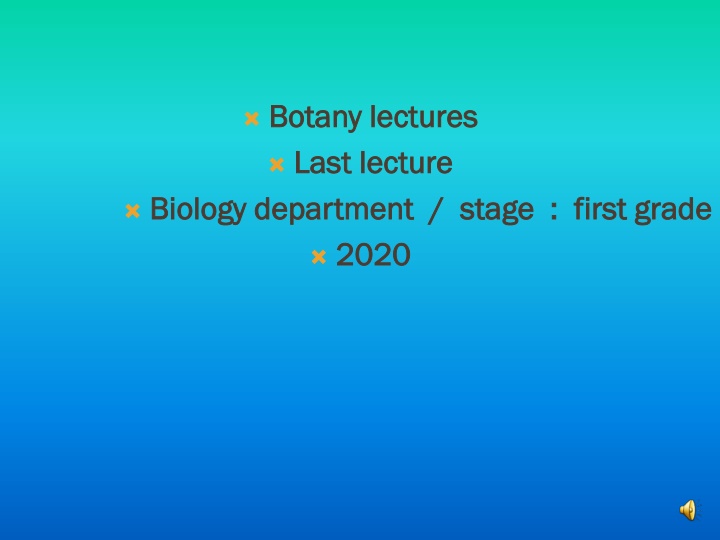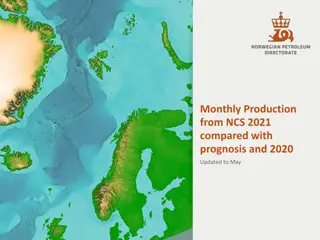
Botany: Stems, Plant Classification, and Stem Structures
Explore the functions of stems in plants, the classification of plants into monocots and dicots, and the characteristics of monocotyledonous and dicotyledonous stems. Learn about the vascular tissues, vascular bundles, and epidermis covering herbaceous dicot stems. Dive into the world of botany and discover the fascinating structures that support plant life.
Download Presentation

Please find below an Image/Link to download the presentation.
The content on the website is provided AS IS for your information and personal use only. It may not be sold, licensed, or shared on other websites without obtaining consent from the author. If you encounter any issues during the download, it is possible that the publisher has removed the file from their server.
You are allowed to download the files provided on this website for personal or commercial use, subject to the condition that they are used lawfully. All files are the property of their respective owners.
The content on the website is provided AS IS for your information and personal use only. It may not be sold, licensed, or shared on other websites without obtaining consent from the author.
E N D
Presentation Transcript
Botany lectures Botany lectures Last lecture Last lecture Biology department / stage : first grade 2020 2020 Biology department / stage : first grade
The stems The stems The main function of stems are to The main function of stems are to 1 1/ support the leaves / support the leaves 2 2/ to conduct water and minerals to the leaves / to conduct water and minerals to the leaves to use it in photosynthesis to use it in photosynthesis 3 3/to transport the products of photosynthesis /to transport the products of photosynthesis from leaves to other parts of plant. from leaves to other parts of plant.
Plants divides into Plants divides into 1 1- - monocots monocots( (have one seed inside the seed have one seed inside the seed coat) coat) have two seed inside the seedcoat seedcoat) ). the 2 2- - dicots dicots( ( have two seed inside
MONOCOTS DICOTS Seed with one cotyledon (seed leaf) . Flower parts multiples of three . Leaf with more or less parallel primary veins Vascular cambium cambium absent Vascular bundles scattered Pollen grains mostly with one aperture Seed with two cotyledons (seed leaves . Flower parts mostly in fours or fives or multiples of four or five Leaf with a distinct network of primary veins Vascular cambium, and frequently cork cambium, present Vascular bundles of stem in a ring in threes or and cork of stem Pollen grains mostly with three apertures (thin areas in the aperture wall see Figures 23.6 and 23.7)
Monocotyledonous Stems Monocotyledonous Stems Most monocots ( Most monocots (e. e.g., herbaceous plants that do not attain great size. herbaceous plants that do not attain great size. The stems have neither a vascular cambium nor a The stems have neither a vascular cambium nor a cork cambium and thus produce no secondary cork cambium and thus produce no secondary vascular tissues or cork. vascular tissues or cork. g., grasses, grasses, lilies) lilies) are are
As in herbaceous As in herbaceous dicots stems are covered by an epidermis, stems are covered by an epidermis, but the xylem and phloem tissues produced by the xylem and phloem tissues produced by the procambium procambium appear in cross section as appear in cross section as discrete vascular bundles discrete vascular bundles dicots, , the surfaces of the the surfaces of the but the
scattered throughout the stem instead of being scattered throughout the stem instead of being arranged in a ring ( arranged in a ring (Fig. Fig. 6.12 6.12). ). Each bundle, regardless of its specific location, regardless of its specific location, is oriented so that its xylem is closer to the center of the stem that its xylem is closer to the center of the stem and its phloem is closer to the surface. and its phloem is closer to the surface. Each bundle, is oriented so
In a typical monocot such as corn, In a typical monocot such as corn, a bundle xylem usually contains two large vessels with xylem usually contains two large vessels with several small vessels between them . several small vessels between them . a bundle s s
Dicot Dicot stems: stems: Typical Typical dicot 1 1/ / presence of well presence of well- - defined epidermis with defined epidermis with cuticle. cuticle. 2 2/ /cortex has cortex has collenchyma collenchyma tissue as a layer under the epidermis or as discontinuous under the epidermis or as discontinuous patches. patches. 3 3/ / vascular bundles are open model and vascular bundles are open model and arranged in a ring surrounding pith. arranged in a ring surrounding pith. 4 4/ / the center of pith is formed from of the center of pith is formed from of parenchyma tissue parenchyma tissue. dicot stem show following characters: stem show following characters: tissue as a layer
SPECIALIZED STEMS SPECIALIZED STEMS Rhizomes Rhizomes Rhizomes Rhizomes : are horizontal stems that grow below ground, often near the surface of the soil.( as in iris ). 2 2. .Tubers Tubers Tubers are enlarged stem structures used as storage organs for nutrients (as in potato). 3 3. .Bulbs Bulbs Bulbs is modified stems underground represent the resting stage of certain seed plants(as in onion). 4 4. . Cladophylls Cladophylls They are green cylindrical or flattened leaf-like branch of limited growth ( as in Asparagus).
The leaves The leaves Leaves Leaves are the flat green part that grow from a plant stem and that function mainly in making food by photosynthesis. Parts of leaf: Parts of leaf: 1 1- -leaf base: leaf base: this is the part were a leaf attaches to the stem, leaf base has two small leaf-like structure called stipules. 2 2- -petiole petiole:is the long, thin stalk that links the leaf blade to the stem. 3 3- -lamina: lamina: also known as leaf blade, its green, flat surface. It consists of a small branched vein and veinlets.
Types of leaves: Types of leaves: A/ A/ Simple leaf: Simple leaf: when a single blade is connected to the main stem by a petiole(ex: cucumber leaf). B/ B/ Compound leaf: Compound leaf: is a leaf made up of two or more leaflets, her the midrib of the leaf is branched into different leaflets and is connected by a single petiole( ex: palm leaves).
Venation of leaves: Venation of leaves: Venation of leaves:
1 1- -reticulate venation: reticulate venation: the veinlets are randomly arranged and form a complex network of veinlets (ex: dicotyledon plants like Rose 2 2- -parallel venation: parallel venation: the veinlets run parallel to each other. (ex: monocotyledon plants like Cana Cana indica indica plant). Rose plant).
leaf venation leaf venation
Phyllotaxy Phyllotaxy of leaves arrangement of leaves on the stem. 1 1- -alternate alternate: a single leaf develops at each node on stem alternatively. 2 2- -opposite opposite: a pair of leaves develops at each node opposite to each other. 3 3- -whorled: whorled: more than two leaves develop at each nodes to form a whorl of leaves. of leaves: is the pattern of
SPECIALIZED LEAVES SPECIALIZED LEAVES Shade Leaves Shade Leaves because leaves in the shade receive less total light needed for photosynthesis, they tend to be larger than their counterparts in the sun. In addition, since they receive less intense sunlight and heat, they are thinner, and have fewer well-defined mesophyll layers and fewer chloroplasts. They also do not have as many hairs. Tendrils Tendrils There are many plants whose leaves are partly or completely modified as tendrils. when curled tightly around more rigid objects, help the plant in climbing or in supporting weak stems. tendrils. These modified leaves,
Spines and Thorns Spines and Thorns The leaves of many cacti and other desert plants are modified as spines. spines. This reduction in leaf surface correspondingly reduces water loss from the plants, and the spines also tend to protect the plants from browsing animals. In such desert plants, photosynthesis, which would otherwise take place in leaves, occurs in the green stems. Storage Leaves Storage Leaves Desert plants may have succulent leaves (i.e., leaves that are modified for water retention). The adaptations for water storage involve large, thin-walled parenchyma cells.
The flower The flower The flower: is the part of a plant which is often brightly colored, grows at the end of a stem, it represent the reproductive organ in plant, and it survive only for a short time. Flower parts: 1 1- -peduncle peduncle: this is the stalk of the flower. 2 2- -receptacle receptacle: the part of the flower to which stalk is attached to, its small and found at the center of the base of the flower. 3 3- -sepals: sepals: small, leaf-like parts growing at the base of the petals, they form outer layer that protect the flower, generally they green colored, and collectively they called calyx. calyx.
4 4- -petals: petals: it lies above the sepals, often bright colored, their main function is to attract pollinators such as insects, the petals are collectively known as the corolla. corolla. 5 5- -stamens stamens: these are male parts of a flower. Many stamens collectively called Androcium structurally divided into two parts: 1 1/filament /filament 2 2/ anthers / anthers 6 6- -pistil: pistil: this form the female parts of a flower. A collection of pistils is called the Gynoecium **Pistil consists of four parts: 1-stigma 2-style 3-ovary 4-ovules Androcium, they are Gynoecium.
The fruit The fruit Fruit is the ripened ovary, together with seeds, of a flowering plant. Parts of fruit: Parts of fruit: 1/ epicarp: the outer layer 2/ mesocarp: middle layer, fleshy, edible poetion of fruit. 3/endocarp: inner layer, rough portion where the seeds is accommodated.
Types of fruits: Types of fruits: 1 1- -simple: simple: one fruit has developed from the ovary of a single flower (ex: fleshy like tomato, dry like coconut). 2 2- -aggregate: aggregate: a fruit formed from several ovaries of one flower that produces many tiny fruits clustered tightly together (ex: strawberry). 3 3- -multiple: multiple: a fruit formed from the fusion of the ovaries of many different flowers which develop closely together to form one bigger fruit ( ex: pineapple, figs).



















